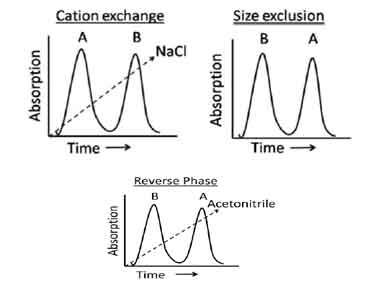Dear Students,
Welcome to Biophysics MCQ-05. This MCQ set consists of Advanced Biophysics and Instrumentation Multiple Choice Questions taken from the previous year question papers of CSIR JRF NET Life Sciences Examination. These questions can be used for the preparation of CSIR JRF NET, ICMR JRF, DBT BET JRF, GATE and other University Ph.D Entrance Examinations.
You may also like: Biophysics Notes | Biophysics PPT
(1). A mixture of two proteins was subjected to following three chromatographic columns: a) Cation exchange, b) Size exclusion (Sephadex 100) and (c) Reverse phase. Following elution profiles were obtained.

Which of the following statements is correct?
(a). Ais larger and more hydrophobic than B.
(b). B is more anionic and more hydrophobic than A.
(c). A is more hydrophobic and smaller than B.
(d). A is more cationic and smaller than B.
Ans. (c)
(2). Lateral diffusion of proteins in membrane can be followed and diffusion rate calculated by:
(a). Atomic force microscopy
(b). Scanning electron microscopy
(c). Transmission electron microscopy
(d). FRAP
Ans. (d).
(3). Labelling of membrane spanning domain of any integral membrane protein in a given plasma membrane vesicle (without disrupting its structure) is successfully carried out by:
(a). Immunochemical methods.
(b). Metabolic labelling with radioisotopes.
(c). Hydrophobic photoaffinity labelling.
(d). Limited proteolysis followed by metabolic labelling.
Ans. (c)
(4). A and B are two enantiomeric helical peptides. Their chirality can be determined by recording their:
(a). Circular dichroism spectrum.
(b). UV spectrum.
(c). Fluorescence spectrum.
(d). Edman sequencing.
Ans. (a)
(5). Which one of the following can be analysed using Surface Plasmon Resonance method?
(a). Radiolabelled DNA probes.
(b). Protein structure.
(c). Optical density of a solution.
(d). Label-free bimolecular interaction.
Ans. (d)
(6). The sequence of the peptide KGLITRTGLIKR can be unequivocally determined by:
(a). Only Edman degradation.
(b). Amino acid analysis and MALDI MS/MS mass spectrometry.
(c). MALDI MS/MS mass spectrometry.
(d). MALDI mass spectrometry after treatment of the peptide with trypsin.
Ans. (a)
(7). Radioimmuno assay (RIA) can be employed for the detection of insulin in blood plasma. For this, 125^I-labelled insulin is mixed and allowed to bind with a known concentration of anti-insulin antibody. A known volume of patients’ blood plasma is then added to the conjugate and allowed to compete with the antigen binding sites of antibody. The bound antigen is then separated from unbound ones and the radioactivity of free antigen is then measured by gamma counter. Following are some of the statements made about this assay.
(i) The ratio of radioactive count for unbound antigen to the bound one is more at the end of reaction.
(ii) The ratio of radioactive count for unbound antigen to the bound one is less at the end of reaction.
(iii) For a diabetic patient, the radioactive count for free antigen is less than that for a normal individual.
(iv) For a diabetic patient, the radioactive count for free antigen is more than that for a normal individual.
Which of the above statements are true?
(a). (i) and (iii)
(b). (i) and (iv)
(c). (ii) and (iii)
(d). (ii) and (iv)
Ans. (a)
(8). A researcher wants to obtain complete chemical information, i.e., head groups and fatty acids of phospholipids from liver tissues. Phospholipids have fatty acids of different lengths and unsaturation and also the head groups are of different chemistries. Which of the following combination of techniques would provide complete chemical description of phospholipids?
(a). Only thin layer chromatography (TLC)
(b). TLC and gas chromatography
(c). Paper and thin layer chromatography
(d). Only paper chromatography
Ans. (b)
(9). Which one of the following microscopes would you use to visualize a protein fused to an appropriate reporter in a living cell?
(a). Fluorescence microscope
(b). Scanning electron microscope
(c). Differential interference contrast microscope
(d). Phase contrast microscope
Ans. (a)
